Traveling to the Source of Spain's Ibérico Ham
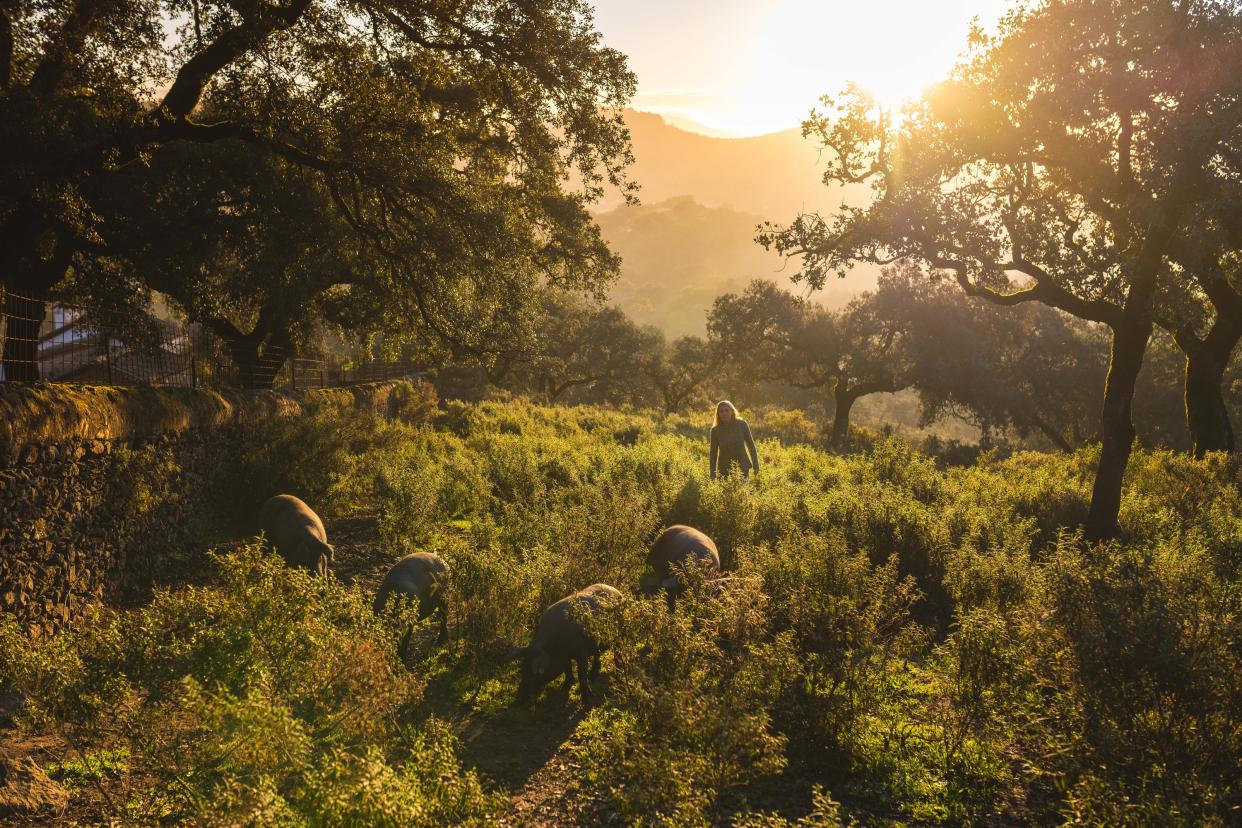
José Salto/Cinco Jotas
The meadow is a vibrant shade of green, with stately trees rising high above a backdrop of rolling hills. The holm oaks spread their branches wide, like an eagle displaying its wingspan, while the cork oaks stand sentinel, their knotted limbs bearing witness to the passage of time. I am standing on Rosa González Nieto’s pig farm in the Sierra Morena of southern Spain, and the scene defies preconceptions. While modern-day livestock operations can be a litany of horrors, the production of Ibérico pork is an outlier—a meat industry that simultaneously protects and relies on its natural environment, provides its animals with a good quality of life, and creates one of the most exquisite products in the world.
The term “pig farm” doesn’t begin to capture the complexity of this place, an ecosystem shaped by humans more than 6,000 years ago. To survive on semi-arid land that was unsuitable for farming, the people who lived here converted the Mediterranean forest to la dehesa (in English: grasslands with evergreen oak trees). It’s a landscape of serene beauty that also happens to be ideal for raising livestock in a sustainable way. For Spaniards, the resulting jamón Ibérico is as much of a cultural symbol as Picasso’s Cubist art, the red wines of Rioja, or Don Quixote’s windmills.
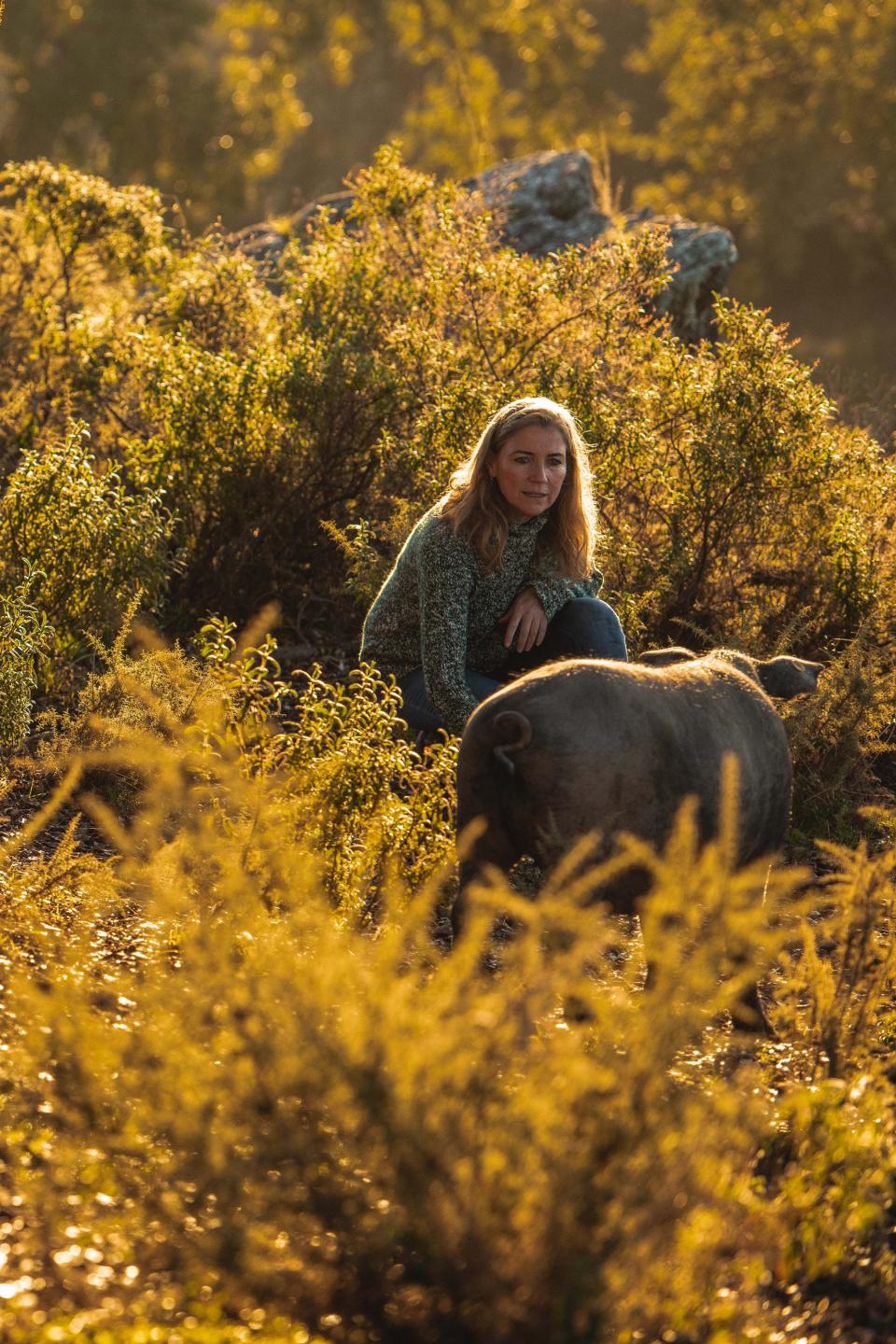
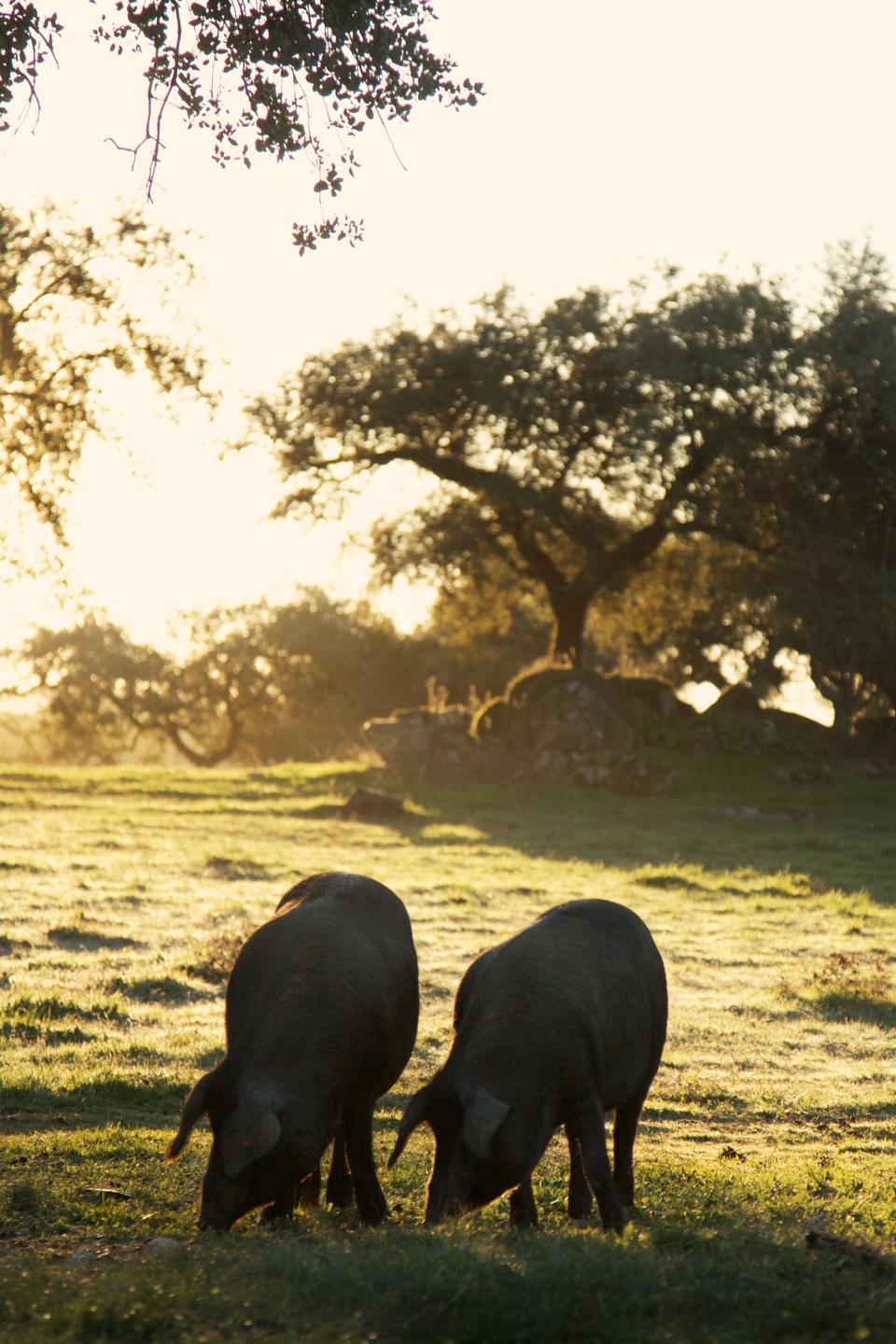
The star of the dehesa is the Ibérico pig, and as I walk around González Nieto’s property, I snap photo after photo of the animals, like a zoological paparazza, to remind myself that I am on a working ranch. But González Nieto, who inherited the farm from her grandfather, is a full-time veterinarian and committed to raising her livestock with care. An indigenous breed of pig, these hardy animals are free range and spend their lives outdoors, foraging for their meals—a combination of grass and acorns (bellotas) produced by the various oaks. Their genetics, movement, and diet result in meat that is nutty, creamy, and slightly sweet, with excellent marbling.
While the Ibérico pig is the headliner here, it is supported by a diverse cast of characters, a web of life that relies on the health of all its members. During my visit, I spot mushrooms sprouting from the soil, learn about honey production, and watch small herds of sheep and cattle happily chomping on plants. These grazers are a fixture on local pig farms, as they thin out excessive greenery, preventing fires and keeping the pastures accessible to the pigs.
But it’s the trees that are the silent heroes of this landscape. Beyond the acorns they produce, majestic oaks offer much-needed shade during hot summers and preserve moisture in the soil, which helps native grasses grow. Despite uncorking more than my share of wine bottles, I have never seen a cork tree up close until now. For nature lovers, it is a humbling experience to stand before these fine specimens, which can grow to heights of 65 feet. Over its 200-year lifespan, a cork oak’s outer bark can be stripped every decade or so without damaging the tree; in fact, a harvested cork oak stores up to five times more carbon than an unharvested one. Gazing up, I admire the bark-covered branches, down to the bright auburn hue of the harvested trunk, a sight that conveys vulnerability and age.
It’s the dehesa’s natural riches that the Spanish government was looking to protect in 2014, when it established a strict labeling system to govern the production of Ibérico pork. The highest quality level is marked by the black label, which means the pigs are 100% pure Ibérico, have a free-range existence, eat acorns, and live on farms with a minimum of about two acres per pig. The red label is nearly the same, except the pig only has to be 50% Ibérico. The green label curtails the animals’ range and allows feed in their diets, while those raised for white label products live indoors, eating only feed.
In addition to the animals’ quality of life, black- and red-label production benefits the environment, according to Dr. Vicente Rodríguez-Estévez, a veterinary professor who directs the University of Córdoba’s center for organic livestock farming. “Free-range Ibérico pig farming actually sequesters more carbon than it produces—thanks to the animals’ diet and the carbon that’s stored in the soil. Where else can you find pig production that mitigates climate change?”
Once farmer González Nieto’s pigs reach maturity here in the Sierra Morena, she sells them to Cinco Jotas, one of the few ham producers in Spain that makes only black-label Ibérico. The company controls the animals’ genetics and diet, and its space requirement for each pig is more than double the government standard. These steps have made Cinco Jotas a leader in the world of high-end Ibérico (its ham was even served at this year’s Oscars).
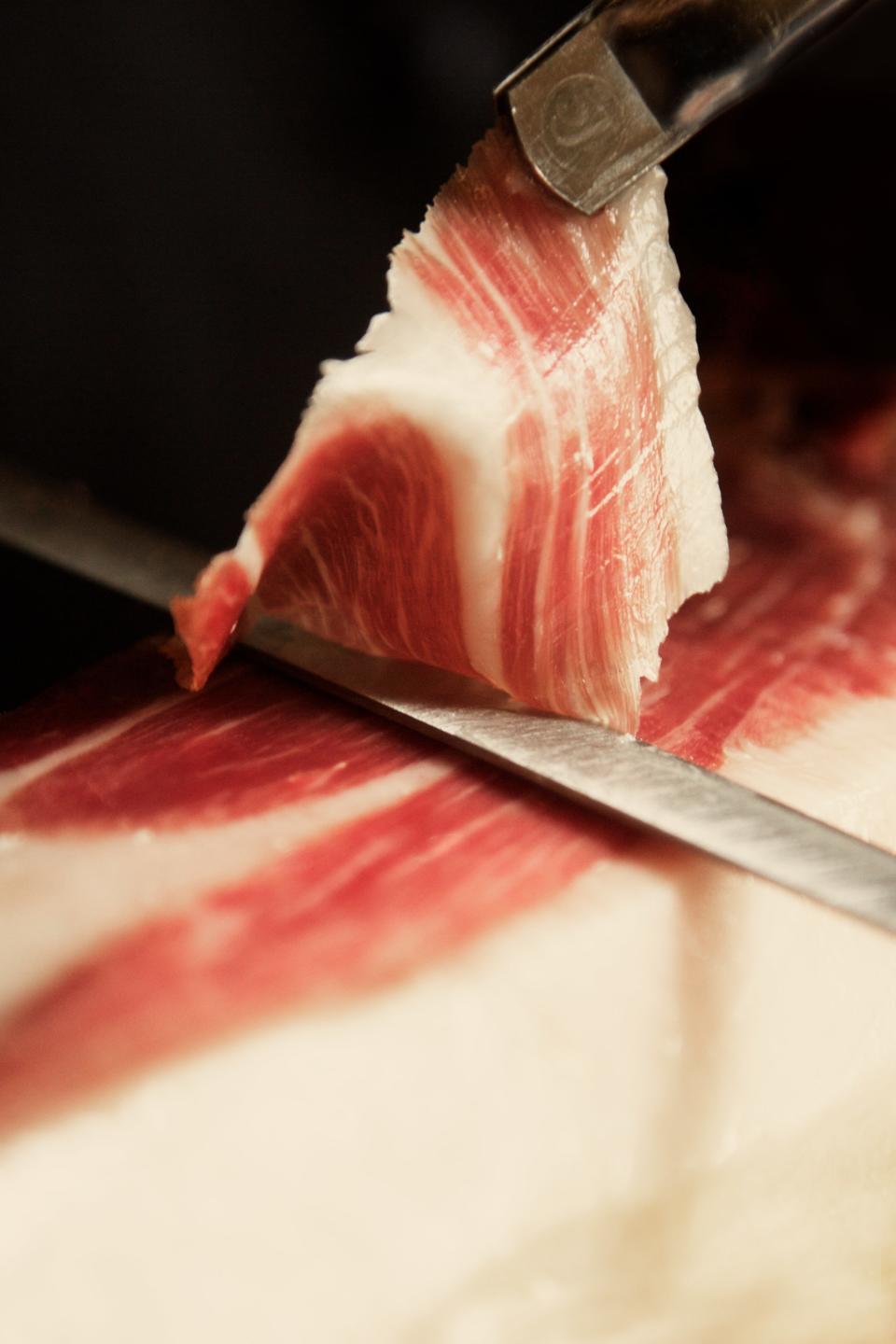
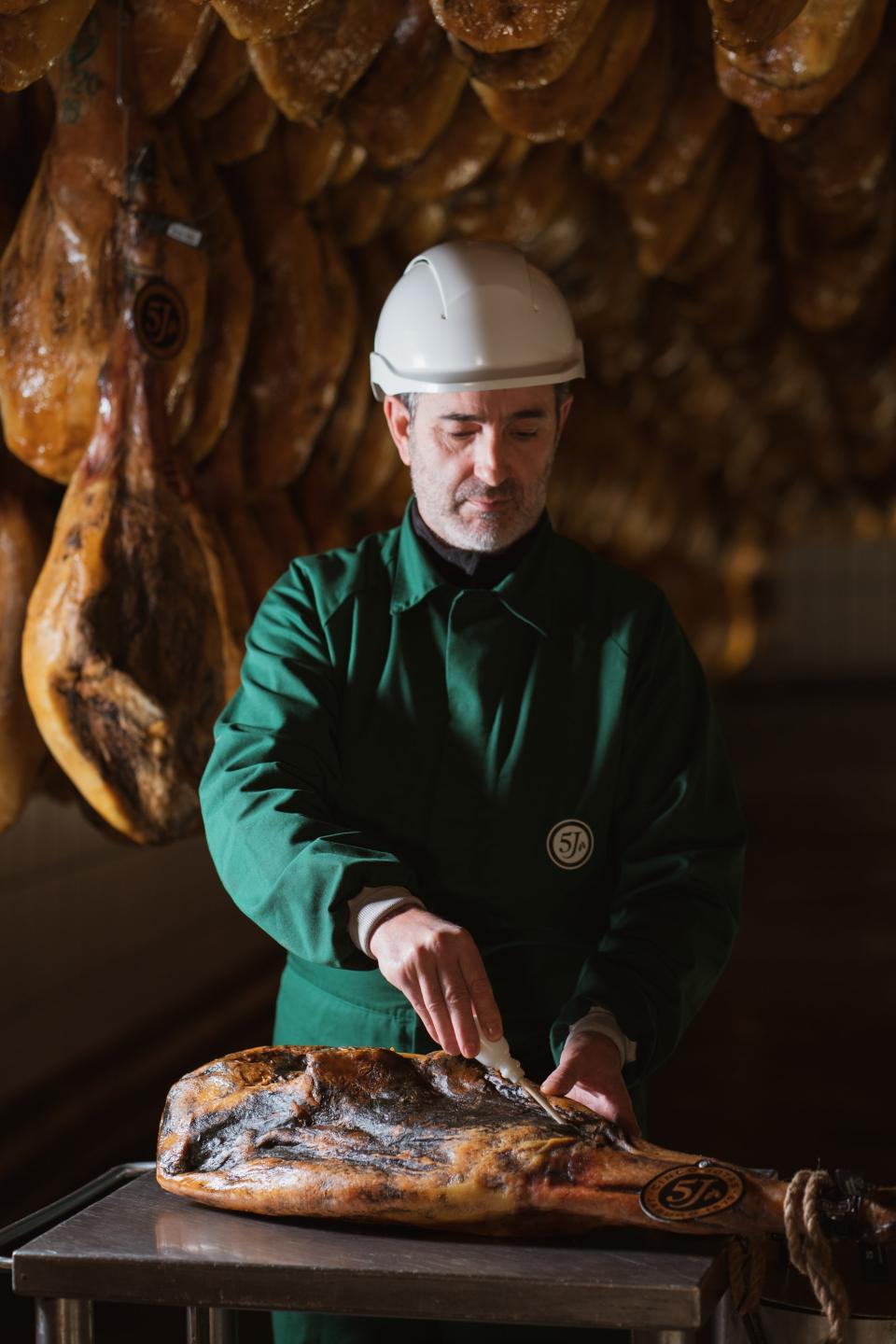
Following a visit to the company’s curing cellars in the town of Jabugo, I met one of Cinco Jotas’ master Ibérico cutters—yes, that’s a thing—and learned how to properly slice the delicacy (though I use the word “learned” loosely). But in my mind, this was merely a prelude to the main event: a decadent tasting of Ibérico ham, chorizo, and other charcuterie, paired with Osborne Sherry and organic caviar produced by Ríofrío.
Later that day, I joined González Nieto and her husband, Francisco Aparicio, for dinner at Russes Gastrobar in the town of Aracena. Over a meal of Ibérico pork—including shatteringly crisp fried pigs’ ears and even a vegetable or two—she tells me about her farm, and how it has become a labor of love. “We have very few animals and a lot of expenses,” she says. “We need support from the government, or else small farmers like us are going to disappear.” That means treating Ibérico as a luxury and putting an economic value on the social and environmental benefits of its production.
Although black-label pork has exceptional flavor and texture, it’s unlikely that the average consumer would consider it inexpensive; on the Cinco Jotas website, a three-ounce packet of sliced ham goes for $49. But after you visit the dehesa, see how the pigs live, and experience the landscape that this industry helps conserve, you can’t help but wonder about all the hidden costs behind the price tag for the cheaper stuff. It’s a matter of priorities, according to María Castro Bermúdez-Coronel, a biologist for Cinco Jotas. “If I want to enjoy nature, I have to support a better kind of ranching and farming,” she says. “Ultimately, we all have to decide what kind of food we want to put into our bodies and what kind of planet we want to have.”
Experience jamón Ibérico at the source
For guided tours of the dehesa and its Ibérico pig farms, try one of these black-label companies.
Cinco Jotas offers a variety of guided experiences, including visits to the pasture and curing cellars, along with tastings and a lesson on slicing the ham at its headquarters in Jabugo (about 70 miles from Seville). Ask about those Sherry pairings.
MIO 1898 is based in Los Pedroches, an hour north of Córdoba. Co-founded by Rafael Muñoz—a veterinarian and the 2018 recipient of the young sustainable farmer award—the company is working to recover a particular variety of Ibérico pig known as Torbiscal. Customized visits can include a stop at the breeding facility and pig farm, as well as tastings. You can even spend the night at a country house in the dehesa.
La Umbría, located between Seville and Málaga, is a family business that used to produce hams under the various colored labels but switched to 100% black-label production a few years ago. This producer’s farm has also earned organic certification. Guided tours include a visit to the pastures and tastings of its ham, charcuterie, pâtés, and cheese, as well as organic fruit and wine.
Originally Appeared on Condé Nast Traveler


